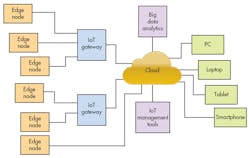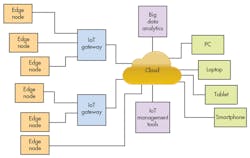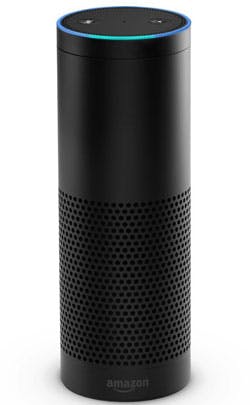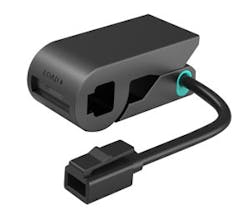What’s the Difference Between Consumer and Industrial IoT?
This file type includes high-resolution graphics and schematics when applicable.
The Internet of Things (IoT) is the latest product-development buzzword, akin to other terms like “the cloud” or “smart cities.” These terms are typically very nebulous, but generally apply to an important set of identifiable products or technologies. They can be more focused, such as “cloud storage” and “cloud computing,” and many companies often identify themselves as providing products and services that fall over these names. The more-focused terminology helps narrow the collection of vendors, products, and services to a more manageable or understandable level. Hopefully, this will be the case with consumer, commercial, and industrial IoT (IIoT).
To start, we need at least a basic description for IoT. Generally speaking, IoT is a distributed network system that typically employs the internet/cloud for some aspect of its communication and usually includes sensors/control systems, a storage component, a compute component, a user-interface component, and possibly gateways (Fig. 1).
Some devices might incorporate multiple components. For example, a smartphone could provide information from its sensors while also running a user-interface application that displayed information moved up to the cloud. It might also act as a gateway to other devices like a smartwatch or a Bluetooth-based sensor.
Granted, the description is very general and a lot of details come into play in an actual system from a plethora of protocols like MQTT and TCP/IP to security and management systems. In theory, an IoT system should be expandable, allowing dynamic changes to its operation and include devices not provided by a single vendor.
Consumer, commercial, and industrial IoT share attributes and are typically built on the same hardware and software platforms. That’s why IoT discussions tend to get murky, especially when delving into the details. For instance, smartphone and tablet apps tend to provide one way of querying and controlling devices. Windows and iOS PCs, on the other hand, generally run the heavier user interfaces, often providing management tools that would be cumbersome on the smaller, portable devices.
The IoT devices and software basically differ in areas such as ruggedness and expected lifetimes, as well as who has access to data and how that data is made available to various parties.
Consumer IoT
Consumer IoT devices and services are oriented toward individual users or families. This includes products like Amazon’s Echo (Fig. 2) or Google’s Nest Thermostat (see “An Elegant Thermostat Designed For The Internet”). Hardware tends to be designed for low cost and limited lifetime and maintenance. A device is likely to have a shelf life measured in months or years, with new versions quickly replacing older products on store shelves. The device lifetime may be many years, but replacement rather than maintenance or upgrade is the norm.
Numerous devices will be unique per consumer, although some may require more than one—e.g., multiple thermostats for a larger house or smart lighting where each bulb is a device. This limited number of devices tends to simplify the user’s management interface software for various reasons, including security. Products are often isolated to a couple of users that may have limited, if any, access controls other than access to the devices using matching applications. From a user’s point of view, the collection of devices and their management is isolated to that user or his or her family.
Typically, a vendor’s device and data-management infrastructure isn’t seen or controlled directly by the consumer, although the user’s management support is provided through it and isolated from other users. This may be related to a vendor’s monetization of consumer information or a mechanism for providing additional services, such as Amazon Echo’s ability to place orders for products or services.
The vendor’s infrastructure is a much different animal than that of the consumer. It will need to manage hundreds, if not millions or billions, of devices, and it needs to take the user partitions into account. The infrastructure may also be built on a third party’s tools or services. The latter is often based in the cloud, and provides connectivity through the cloud/internet. This adds another level of complexity, though, since the third party will have its own management infrastructure to provide its services to the vendor that is, in turn, providing services to its own consumers.
Commercial IoT
Commercial IoT sits between consumer and industrial IoT and shares aspects of both. Some may actually group commercial and industrial IoT together. The scope of commercial IoT typically resides at the company or organization level. Applications like smart power and lighting would fall under the commercial IoT umbrella.
New hardware also supports 4G-LTE connectivity. The cloud-based support employs artificial intelligence (AI) to analyze electrical “fingerprints” and subsequently optimize building controls, sending users critical notifications of energy use. It can also help predict future breakdowns based on system use and operation.
Verdigris’ system highlights some major differences between consumer and commercial IoT systems. The first is scale, followed up by management and analysis. Commercial systems rarely involve single devices—there may be dozens or thousands depending on the application. A number of sites may also be involved in one system, adding to the management challenge.
Moreover, customer management and analysis is substantially more sophisticated versus that of consumer IoT. Hierarchical access control is critical to data and control features. A customer will likely take advantage of database access as well as service APIs and data analytics such as Verdigris’ AI support. AI is not unique in IoT cloud support. Watson AI technology is available as part of IBM’s IoT services, which are accessible from IoT platforms like mbed (see “mbed IoT Starter Kit Links to IBM's Cloud”).
Industrial IoT
Industrial IoT might be viewed as rugged, long-term commercial IoT, but that overlooks the differences in IIoT’s design and infrastructure. Like many commercial solutions, IIoT solutions often target existing automated industrial systems. The difference is that these systems may be older, so the level of sensors is often based on what was available. They provide sufficient information to control the industrial process, but additional information would be useful if it’s possible to incorporate more sensors. Such sensors might track the status of components such as plumbing. Sometimes, it can provide supplemental information about system wear and tear to anticipate maintenance requirements.
Integrating information from existing systems with new IoT support is often more complicated than with commercial IoT. Likewise, integration will need to be maintained over the long term as well as support updates on both sides of the equation. The potential for bidirectional integration also leads to a more-complex security integration process. This is one reason why full IIoT integration generally requires more time than a commercial IoT application.
Like commercial systems, industrial IoT is more amenable to gateway use. Incorporating many gateways requires planning, but they ultimately provide the ability to do more processing on the floor. They also enable more independent operation, with the possibility of distributing information locally.
IIoT gateways will often have more user customization, or even the ability to run user applications. These systems may require significantly more customization than a commercial system in order to tailor them for a particular industrial process.
The customization involved with IIoT systems is one reason why deployment will take longer than many commercial IoT systems. IIoT developers will usually require more support and create more integration solutions, whereas most commercial IoT integration is likely to be done in the cloud. Security, latency, and application issues surrounding IIoT often make cloud type of integration impractical.
IIoT equipment also tends to have more demanding requirements than commercial alternatives. Very long-term support and rugged specifications such as extended temperature support are common requirements for many applications.
So where do IoT applications like smart cars and smart cities fit? Smart cars would fall into the consumer IoT realm, while smart cities might be a mix of commercial and industrial IoT.
IoT systems and platforms are not created equal. The types of communication and operations used by consumer, commercial, and industrial IoT are very similar if not identical. The differences concern those who procure, and are allowed to procure, information or control within the system.
Oftentimes, multiple players are involved in support and management of the software, because building an IoT system from scratch isn’t an easy task. On top of that, supporting it in the long term becomes a full-time job that’s usually very distracting for commercial or industrial companies, and a bit ridiculous for consumers.
About the Author
William G. Wong
Senior Content Director - Electronic Design and Microwaves & RF
I am Editor of Electronic Design focusing on embedded, software, and systems. As Senior Content Director, I also manage Microwaves & RF and I work with a great team of editors to provide engineers, programmers, developers and technical managers with interesting and useful articles and videos on a regular basis. Check out our free newsletters to see the latest content.
You can send press releases for new products for possible coverage on the website. I am also interested in receiving contributed articles for publishing on our website. Use our template and send to me along with a signed release form.
Check out my blog, AltEmbedded on Electronic Design, as well as his latest articles on this site that are listed below.
You can visit my social media via these links:
- AltEmbedded on Electronic Design
- Bill Wong on Facebook
- @AltEmbedded on Twitter
- Bill Wong on LinkedIn
I earned a Bachelor of Electrical Engineering at the Georgia Institute of Technology and a Masters in Computer Science from Rutgers University. I still do a bit of programming using everything from C and C++ to Rust and Ada/SPARK. I do a bit of PHP programming for Drupal websites. I have posted a few Drupal modules.
I still get a hand on software and electronic hardware. Some of this can be found on our Kit Close-Up video series. You can also see me on many of our TechXchange Talk videos. I am interested in a range of projects from robotics to artificial intelligence.







